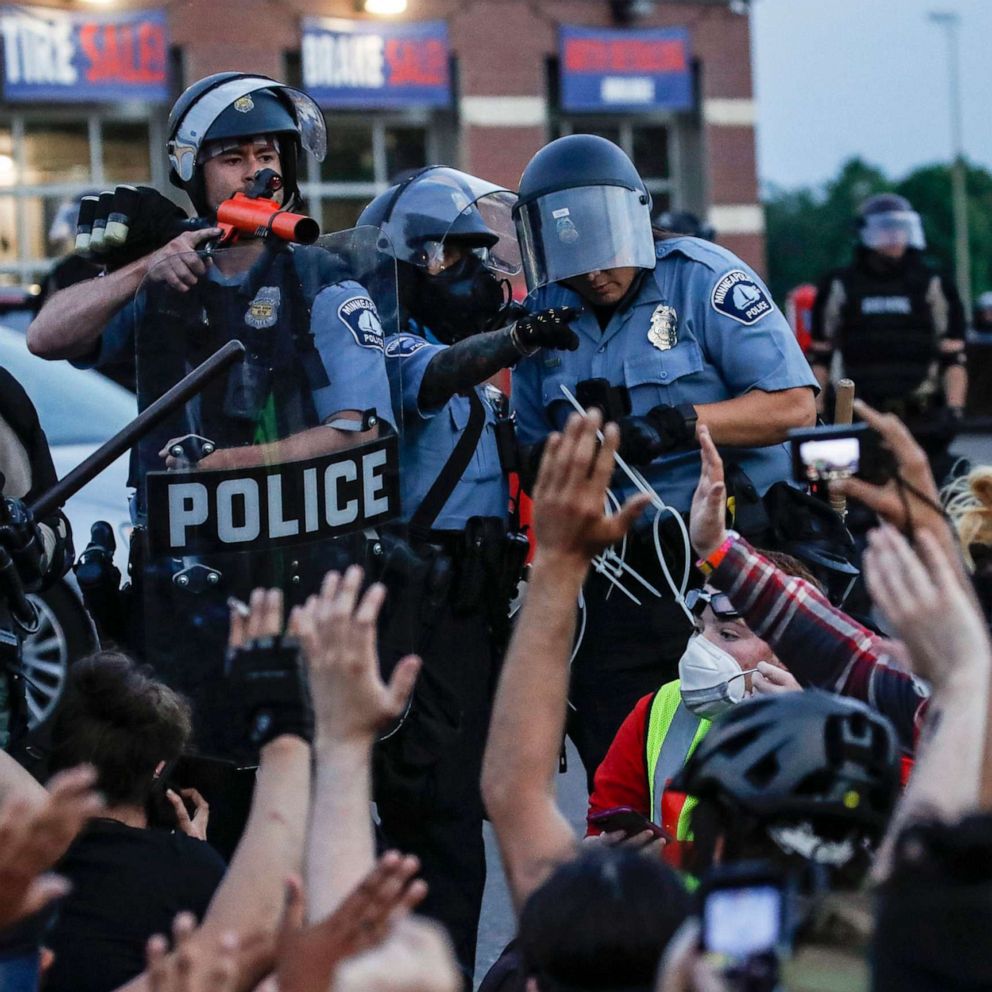'Where there's smoke, there's fire': Is early intervention an effective police reform?
It's one of the Minneapolis Police Department's latest reform measures.
For some 30 years, early intervention systems have been a common reform in police departments. The data-driven approach attempts to identify problematic behavior and intervene with non-punitive measures, such as additional training or a new partner.
The reform measure garnered renewed attention in the wake of George Floyd's death last month while in Minneapolis police custody. Companies that sell early intervention software say they've seen an uptick in interest from police departments. A recent poll by YouGov found that most Americans support using it to identify problematic officers. And last week, Minneapolis Police Chief Medaria Arradondo announced that one of the department's key reforms following Floyd's death is a new partnership with an early intervention system company, Benchmark Analytics.
This won't be Minneapolis' first early intervention system, or EIS. The department has been using one since 2009. Which begs the question, is this reform effective?

Early intervention systems, which over the years have shifted from paper-based to digital automation, are widely considered an important tool and best practice in police reform and accountability, but they haven't been extensively studied, experts told ABC News. The technology doesn't replace attentive relationships between officers and supervisors, strong leadership in departments and best use of the system, they said.
"The software is only as good as the data put into it, regardless of who the company is," Mike Reed, co-owner of the EIS tool Guardian Tracking, told ABC News. "If you're putting garbage in, you're going to get garbage out. It really comes down to quality control."
'Systemic challenges'
Problems with Minneapolis' EIS have been raised before. In 2013, its progressive police chief, Janeé Harteau, asked the Department of Justice to review its police-accountability measures. The subsequent 2015 federal assessment found that the department's EIS had "systemic challenges" and there were gaps in its use. One challenge the report found was in successfully tracking and flagging problematic behaviors due to the system's lack of automation.
Following the report's release, the police department said it would follow one of the recommendations and finalize a new EIS. In its 2016 budget, the city invested in accelerated training for officers in implicit bias, procedural justice and crisis intervention. That year, the department also issued a policy requiring cops to intervene if another became abusive.
A Minneapolis Police Department spokesperson was unable to tell ABC News if the department's EIS had flagged Derek Chauvin, the former officer who was seen on video with his knee on Floyd's neck for almost 8 minutes and was charged with second-degree murder, third-degree murder and second-degree manslaughter. Chauvin, who has not entered a plea, had 18 complaints throughout his nearly 20-year career, and was disciplined for two of those, city records show. The documents do not provide the details of the complaints or the discipline.

During a news conference last week on the reform measures, Chief Arradondo said the department's EIS hasn't worked in the past because academic experts have found that "supervisory action alone to remove problematic officers is very rare and significantly absent in larger departments."
The new partnership with Benchmark Analytics will now allow the department for the first time to use "real-time data and automation to intervene with officers who are engaged in problematic behavior," Arradondo said.
Early intervention in practice
A common refrain in criminal justice circles is "where there's smoke, there's fire."
"Just like criminals who commit terrible crimes typically commit less terrible crimes before that, the same thing is true for rogue officers," Thomas Abt, a senior fellow at the Council on Criminal Justice, told ABC News. "For almost every rogue officer, there's some warning."
Research on officer conduct by the University of Chicago's Center for Data Science and Public Policy has also found problematic behavior to be predictable, Benchmark Analytics CEO and co-founder Ron Huberman told ABC News.
"It is very rare, statistically speaking, for an officer to have a singularly bad experience," Huberman said. "When an officer is engaged in problematic conduct, you will generally see a pattern of problematic conduct, which is why it is a very identifiable thing."
Benchmark's software uses the university's research in its predictive models and algorithms to identify patterns of behavior that might be problematic. Indicators of problematic behavior might include a series of citizen complaints or the use of force.
Through Benchmark, an agency can determine, say, how many times on average force is used in domestic violence calls, which officers are significantly below that average, and which are above. From there, an intervention for an officer prone to greater use of force could range from de-escalation training to being paired with an officer who has used less force in those instances, Huberman said.
Officers who have a pattern of problematic conduct often tend to work together, Huberman added, which makes partnering them with a high-performing officer a potentially effective form of intervention.
For Reed, of Guardian Tracking, signaling out exemplary behavior can be just as important as problematic. He prefers the terminology "early intervention system" over the interchangeable "early warning system."
"I was around when the phrase first came about in the 1990s -- it has such a negative connotation," Reed, a retired lieutenant, said. "We want to recognize excellence and celebrate success, but we also want to be aware of certain problems so that we can address those effectively."
Lack of research
There is limited research on EIS, which makes it hard to say if the reform works, some academics say.
"The science that undergirds EI systems is pretty thin," Robert Worden, director of the John F. Finn Institute for Public Safety and an associate professor of criminal justice and public policy at SUNY Albany, told ABC News. He added that most of the available research was done in the 1990s and early 2000s.
EIS is "promising, but not proven," Abt said. "The research supporting early warning systems is not particularly strong."
Rashida Richardson, director of policy research at the AI Now Institute at New York University, told ABC News that the use of AI and data analytics in the field "is a welcome shift," but there aren't enough case studies for her to determine if it's an effective form of reform.
Surveys have also shown issues in the execution of the reform. The Finn Institute surveyed 243 police agencies on their EIS use in 2014. Among its findings was that oftentimes sergeants said they were trained in how to use the software, but not in what to do afterward, Worden said. Those kinds of factors "weren't the subject of an EIS protocol."
Worden has also found some EIS indicators, like citizen complaints and use of force, to be unreliable misconduct flags.
"When police work is properly done, it might very well eventuate in the use of force. It might even eventuate in a citizen complaint," Worden said. "The real problem with early intervention at the outset is differentiating the smoke of misconduct from the exhaust of routine, properly performed police work. Social research right now doesn't really enable us to distinguish the two."
The Finn Institute is in the middle of conducting a study on the structural details of EIS, such as how they identify officers who need intervention and what the intervention should be. Worden said he expects to have something to disseminate by the end of the year.
Benchmark, which started working with police departments three years ago, is also studying anonymized data from its 70 or so partner cities. Through a research consortium that includes the University of Chicago, which is a part owner of the company, it hopes to "get smarter about issues of police conduct and police intervention," Huberman said.
"This is something that in the modern world of political science is new," Huberman said. "Interventions and the efficacy of police interventions, up until this point, have all but not been studied."
Huberman said he expects to have more information on this research in six months to a year.
Beyond technology
Like any piece of tech, EIS has to contend with potentially fallible human beings.
"Technology does not replace the need for competent human judgment and management," Abt said. "It’s only as good as the people using it."
Guardian Tracking works with more than 1,100 organizations, the majority of which are police departments. It incorporates both in-system alerts and emails, starting from when an employee is flagged to when any determined course of action is completed.
"Our intent was to keep things from falling through the cracks," Reed said.

More direction and guidance for supervisors in determining what type of intervention to take is also needed, Worden said.
"EI systems can't stand on their own," he said. "They are properly part of a much larger managerial system of direction and oversight."
Good day-to-day supervision is also its own form of early intervention, Worden added, pointing to what criminal justice expert Samuel Walker describes as "early-early intervention."
For Reed, EIS can be a "vital" tool for recognizing and addressing problems effectively. But "if you're that engaged servant leader who knows your people, you don't need a piece of software to know there's a problem."
EIS, of course, is also just one part of reforming policing in the U.S., as states and cities announce a range of reform measures, from banning the use of "no-knock" warrants to diverting police funds.
"Technology won’t change the entire system," Abt said. "People are searching for the silver bullet, but it’s not going to be about one big thing. It’s going to be about dozens of little things."







